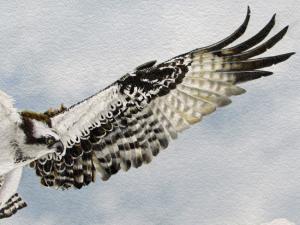Looking for design inspiration? Browse our curated collections!
November 5th, 2014 - 09:50 AM

I continued work on the Osprey in flight this past week, completing the outstretched left wing.
For a seemingly near monotone structure, I used a surprisingly large number of colors. The list includes dark sepia FC, warm grey I and II FC, French grey 50%, 70% and 90%, raw umber FC, burnt umber FC and white FC. They all had their places but it is possible that I could have done it with a shorter list. I just grabbed what I thought would look right at a particular moment. The feathers are not just black and white striped or grey and white striped but vary subtly depending on how the light strikes them. Some light umber shows as highlights when the light hits the feather right. The feathers are turned this way and that as the wind catches them and the bird moves them up and down in the air. The feathers are not completely flat either. There can be a slight bending on either side of the central shaft or rachis. So, the light will be caught differently on either side. You can see that in some of the feathers, where one side of the shaft is lighter than the other. I also hinted at the striated nature of the vane, the barbs running out from the shaft, especially in the primary feathers. I did this by first coloring in the vane with a bit of raw umber, then filling in the vane with lines of dark sepia. I needed to keep a very sharp point on the pencil.
The bird in flight is now pretty much completed but I may have to make some changes to tones on the bird as I progress through. Everything is relative to everything else, so, as I progress through, I look at each element and make changes in tone here and there until I think all the parts look right relative to one another.
I think next Iíll be starting on the nest.
Comments
There are no comments on this blog. Click here to post the first comment.